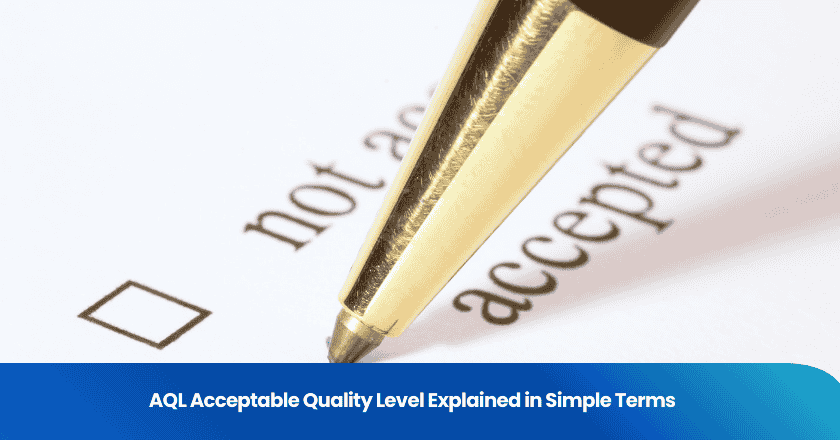
AQL acceptable quality level sets a clear benchmark for product quality during inspections. Companies use aql to determine how many defective items they can accept in a batch while maintaining consistent product quality. This system helps those involved in product inspections make objective decisions about aql acceptable quality level without checking every single item. Aql simplifies inspections, supports quality control, and ensures that products meet the required standards. By understanding aql, teams can improve inspections and achieve better results in product quality.
What Is AQL Acceptable Quality Level?
AQL Meaning
AQL stands for "Acceptable Quality Level." This term describes the maximum number of defective units allowed in a batch during product inspection. Manufacturers and buyers use aql to set clear expectations for product quality. The aql acceptable quality level acts as a benchmark for deciding if a batch passes or fails inspections.
Aql standards help companies avoid inspecting every single item. Instead, inspectors check a sample from the batch. If the number of defects in the sample stays within the acceptable quality level, the batch passes. If defects exceed the limit, the batch fails.
Note: The acceptance quality limit is another term for aql. Both refer to the threshold that separates acceptable batches from those that need further action.
Aql acceptable quality level supports consistent product quality. It gives everyone involved in product inspection a common language for quality control.
Purpose in Inspections
Aql acceptable quality level plays a key role in inspections. It helps inspectors decide quickly if a batch meets the required standards. Companies use aql to balance quality control with efficiency.
During product inspections, inspectors select a sample size based on aql standards. They check for defects and compare the results to the acceptable quality level. This process saves time and resources. It also ensures that product quality remains high without inspecting every item.
Aql guides inspectors in making objective decisions. It reduces the risk of passing poor-quality products or rejecting batches that meet standards. The system supports fair and consistent product inspection across different industries.
| Purpose of AQL in Inspections | Benefit to Companies |
|---|---|
| Sets clear quality benchmarks | Ensures product quality |
| Streamlines product inspection | Saves time and cost |
| Supports quality control | Reduces risk of errors |
| Provides objective criteria | Improves consistency |
Aql acceptable quality level helps companies deliver reliable products. It strengthens quality control and builds trust with customers. Product inspections become more efficient and effective with aql.
How AQL Works
Defect Types
Inspectors classify defective items into three main categories: critical, major, and minor. Each type affects the selection of the acceptable quality level during product inspection.
- Critical defects pose safety risks or violate regulations. These defects require the strictest standards.
- Major defects impact product function or appearance. Customers may reject products with major defects, but these do not threaten safety.
- Minor defects do not affect product use or safety. Customers may notice these flaws, but they usually accept them.
Aql helps inspectors set the right acceptance quality limit for each defect type. For critical defects, the aql threshold is very low, often set at zero. Major defects allow a slightly higher acceptable defect rate. Minor defects have the highest acceptable defect levels. This system ensures that product quality matches customer expectations and regulatory requirements.
Tip: Defining defect types before inspections helps teams apply the correct aql threshold and maintain consistent quality control.
Sampling Basics
Inspectors rarely check every item in a batch. Instead, they use aql sampling to select a random sample inspection. This method saves time and resources while maintaining reliable product quality.
Aql sampling involves choosing a specific number of items from the batch. Inspectors perform random sample inspection to find defective items. They compare the results to the acceptable quality level and the acceptance quality limit.
The size of the sample depends on the total batch size and the chosen aql threshold. For example, a batch of 1,000 units may require a random sample inspection of 80 items. If the number of defective items in the sample stays within the aql threshold, the batch passes. If inspectors find more defects than allowed, the batch fails.
| Batch Size | Sample Size | AQL Threshold | Pass/Fail Decision |
|---|---|---|---|
| 500 | 32 | 1.5 | ≤ 1 defect: Pass |
| 2,000 | 125 | 2.5 | ≤ 7 defects: Pass |
| 10,000 | 315 | 0.65 | ≤ 2 defects: Pass |
Aql sampling and random sample inspection help companies control product quality without inspecting every item. This approach supports efficient inspections and consistent results.
AQL Numbers
Aql numbers represent the maximum percentage of defective items allowed in a sample. Inspectors use these numbers to set the aql threshold for each inspection.
Lower aql numbers mean stricter standards. For example, an aql of 0.65 allows fewer defective items than an aql of 2.5. Higher aql numbers indicate a more relaxed acceptable quality level.
The acceptance quality limit guides inspectors in deciding if a batch meets product quality standards. Aql numbers range from 0.01 (very strict) to 6.5 (more lenient). Most industries use aql thresholds between 1.0 and 2.5 for major defects.
Note: Choosing the right aql number depends on defect type, product quality requirements, and customer expectations.
Aql numbers help inspectors make objective decisions during product inspection. They support quality control by providing clear criteria for acceptable defect levels. Teams use aql thresholds to maintain consistent inspections and deliver reliable products.
Using AQL Tables
Steps to Use
AQL tables help inspectors decide how many items to check and what counts as an acceptable quality level. They follow a clear process to use these tables during inspections:
1. Inspectors identify the total batch size for the inspection.
2. They select the inspection level, usually General Level II for most product quality checks.
3. Inspectors find the corresponding sample size code letter in the AQL table.
4. They locate the sample size and match it with the chosen aql value for each defect type.
5. Inspectors check the acceptance criteria, which shows the maximum allowable number of defects for the sample.
6. They perform the inspection and compare the results to the table to decide the acceptability of a lot.
Tip: Always use random sampling to ensure fair inspections and reliable results.
AQL Example
Suppose an inspector needs to check a batch of 2,000 units. They choose General Level II and an aql of 1.5 for major defects. The AQL table shows a sample size of 80 units. The acceptance criteria allow up to 2 major defects in the sample. If the inspector finds 2 or fewer major defects, the batch passes. If they find 3 or more, the batch fails. This process helps maintain consistent product quality and ensures inspections follow industry standards.
Choosing Levels
Selecting the right aql level depends on the product type and defect severity. Critical defects require the strictest aql, often set at zero. Major defects use a moderate aql, while minor defects allow a higher acceptable quality level. Inspectors consider customer expectations and product safety when choosing these levels. The correct aql ensures inspections protect product quality and meet the maximum allowable number of defects for each batch.
Acceptable Quality Level: Benefits and Limits
Key Benefits
AQL offers several important advantages for companies focused on quality management. This system provides a clear and objective way to measure product quality during inspections. Teams can use AQL to set specific standards for different types of defects, which helps maintain consistency across batches.
- Efficiency: Inspectors do not need to check every item. AQL sampling saves time and resources while still supporting strong quality control.
- Objectivity: AQL tables and numbers give inspectors a reliable method for making pass or fail decisions. This reduces personal bias and supports fair inspections.
- Flexibility: Companies can adjust AQL levels based on product type, customer requirements, or industry standards. This flexibility helps meet a wide range of quality management needs.
- Customer Confidence: Consistent use of AQL in inspections builds trust with customers. They know that products meet agreed-upon quality standards.
AQL supports quality control methods that help companies deliver reliable products and improve their reputation in the market.
Main Limitations
While AQL brings many benefits, it also has some limits that companies should understand. AQL does not guarantee that every product in a batch is defect-free. Instead, it sets an acceptable risk level for defects based on sampling.
- Sampling Risk: Inspectors might miss some defects because they only check a sample, not the entire batch.
- Not Suitable for All Products: Some products, especially those with strict safety requirements, may need 100% inspection instead of AQL sampling.
- Complexity for New Users: Teams new to AQL may find the tables and calculations confusing at first. Training and experience help overcome this challenge.
AQL remains a valuable part of quality management and quality control. Companies should understand both its strengths and its limits to use it effectively in inspections.
Aql gives teams a clear method for managing product inspections and setting quality control standards. By understanding aql, inspectors can make better decisions and improve inspection results. Aql helps companies maintain consistent quality control across different products. Teams who use aql in daily work see fewer mistakes and more reliable outcomes. Anyone interested in learning more about aql or quality control can explore industry guides or take online courses. Applying aql knowledge leads to stronger quality control and better products.
FAQ
What does AQL stand for?
AQL stands for Acceptable Quality Level. This term defines the maximum number of defective items allowed in a sample during product inspection.
How do inspectors choose the right AQL level?
Inspectors select the AQL level based on product type, customer requirements, and defect severity. Critical defects require stricter AQL levels, while minor defects allow higher thresholds.
Can AQL guarantee zero defects in a batch?
AQL does not guarantee zero defects. It sets an acceptable risk level by sampling. Inspectors may miss some defects because they do not check every item.
Why do companies use sampling instead of checking every product?
Sampling saves time and resources. Inspectors use AQL tables to check a small, random sample. This method provides reliable results without inspecting every unit.
What happens if a batch fails an AQL inspection?
If a batch fails, the company may reject, rework, or inspect the entire batch. The next steps depend on company policy and customer agreements.
Grow your business with TradeAider Service
Click the button below to directly enter the TradeAider Service System. The simple steps from booking and payment to receiving reports are easy to operate.



